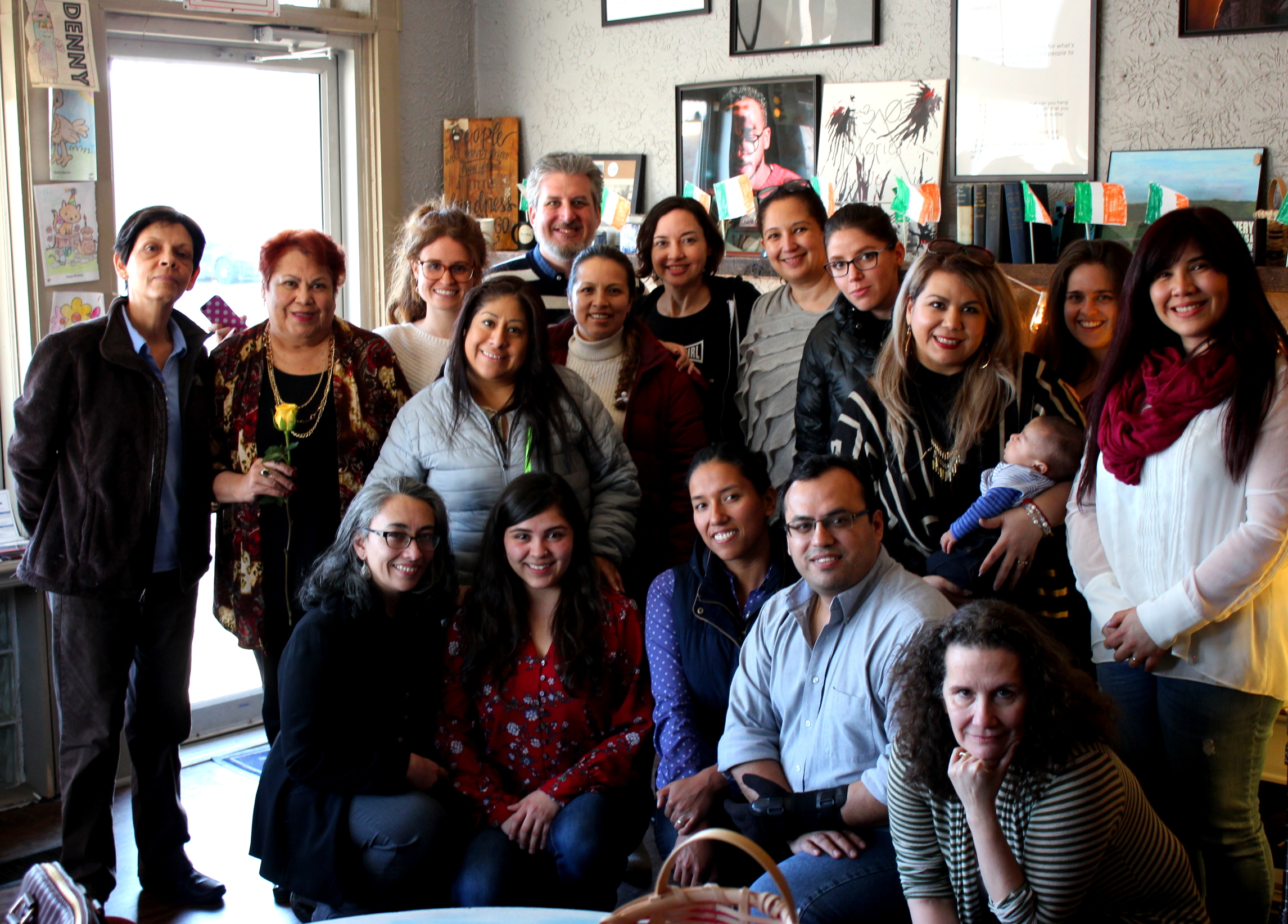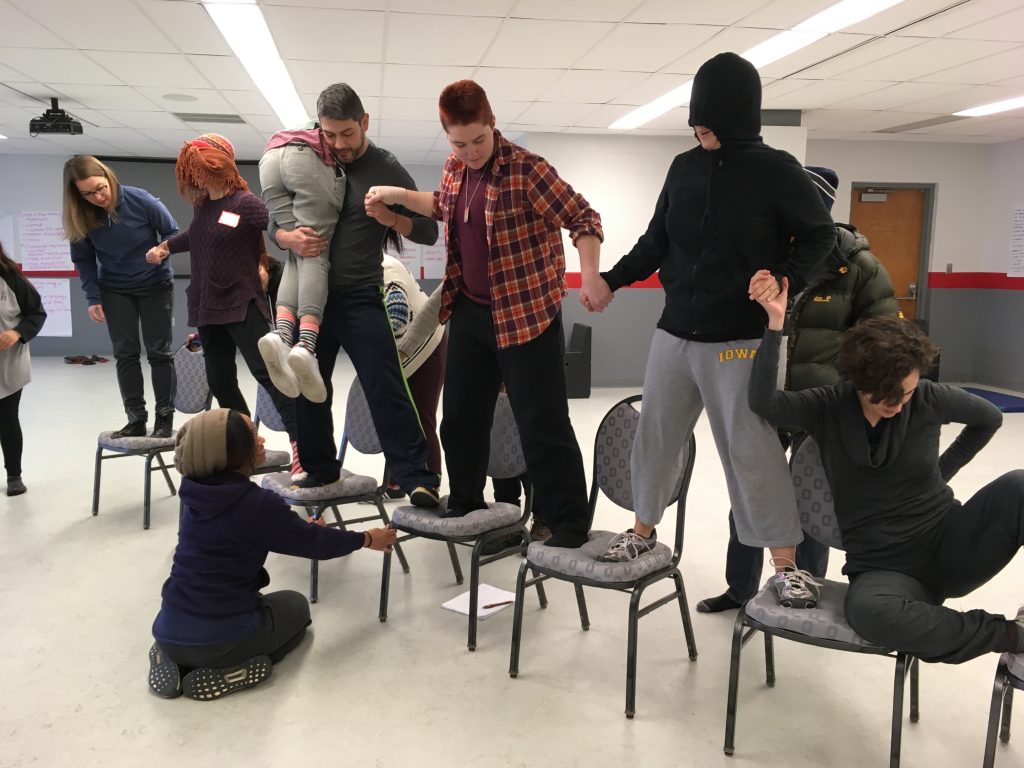
Participants at OSU Be the Street August 2017 Workshop with Albany Park Theater Project construct a “Time” machine
As described in an earlier post, the first half of Be the Street’s intensive workshop with Albany Park Theater Project focused on building an ensemble from students and faculty across the Arts and Humanities at OSU. The second half of the intensive focused more explicitly on crafting performance from real-life stories through a combination of ethnographic interview and theatrical devising. Short-form devising based on self-exploration bridged these two halves. Small exercises designed to plumb our own personal histories generated material for group exploration. Exposing ourselves to scrutiny in this way was a crucial step toward the challenge of imagining and incorporating the life experiences of others, but equally crucial was the support of the ensemble we had built.
In small groups, we related stories from when we were young. We collectively decided which stories to enact, thus inviting group members into our stories and their telling. Individually, we built “life graphs,” which chronicled significant people, places, and events in our lives, and then we animated these by creating a sequence of movement that reflected images or metaphors we associated with key moments in our lives. These sequences were shared in groups of various sizes and in spaces of various sizes. The smaller the groups became and the more constricted the space, the more the performers interacted with each other and their life stories became intertwined. The techniques explored individually and in small groups served as building blocks for long-form devising on the basis of other people’s life stories.

David Feiner, Albany Park Theater Project Producing Artistic Director leading an interview analysis exercise at OSU Be the Street August 2017 Workshop
David Feiner, Producing Artistic Director for Albany Park Theater Project, provided an interview that was part of a recent performance project. “Josephina,” as the woman was called, recounted her experience of running away from home and crossing the U.S.-Mexico border at a young age, and her current struggle to keep her husband from being deported while sustaining her children financially and emotionally. Reverse-engineering the interview, we applied the same techniques we had previously used on our own stories to enter into Josephina’s account. We identified themes, key people, and a chronology of events. APTP Directors David Feiner, Maggie Popadiak, and Stephanie Paul added a few more layers as we worked with the interview: the image wheel, where we each responded to themes from the interview by shaping ourselves into static sculptures, machines, which brought such sculptures together and added elements of movement and sound, and sleep talking.
Machines, so-called because of their component human parts working together, were a particularly powerful way to explore themes from Josephina’s story as a group. Each machine began with a single person responding to an idea, and embodying that idea with repeating movement and sound. For example, we built a machine based on Time, since much of Josephina’s story centered on feeling like time was both the enemy and the unknown. One person provided an opening gesture, and, one-by-one, others joined in while many stood as witnesses to the unfolding drama. Like the ‘I Come From’ Orchestra, machines require that each participant examine what precedes their entry and how their addition complements and contributes to the exploration. Once a group has congealed, a director can modulate the group’s energy, volume, and speed for further exploration, or individuals can break off to form new machines.
As we had done with our own life graphs, we also animated Josephina’s life graph, working in groups to depict key moments and metaphors from the interview. Later, we added a layer of text, using snippets of Josephina’s own evocative prose to allow our compositions to register on visual, auditory, and kinesthetic planes simultaneously.
An important question arose as we grappled with bringing Josephina’s story into our bodies through movement, and as we used her words and images to build little worlds from her interview text: What was our obligation to Josephina, to her experience, to her story and her self-narration in this process of devising performance? What right did we have to tell her story? Feiner reiterated that theirs is not documentary theater, so there isn’t a question of performing biography or of representing stories exactly as they are told. When community members consent to be interviewed by members of the APTP ensemble, it is with the understanding that their stories function as inspiration for a larger production that weaves many stories and perspectives together. This approach contributes to anonymizing interview subjects, many of whom are likely to be from vulnerable populations, and it allows one character to become a vehicle for many people’s stories. Those who offer their stories to the process will continue to recognize themselves in the resulting work, but because there is no longer a story that belongs to a single person alone, each scene becomes a story of the community—everyone has a stake in the story and its outcome.
Feiner offered another way to work through the sticky appropriative implications of building performances from other people’s stories. In theatrical training, it is not uncommon to mine one’s own experiences to identify with a character and bring life to that character through determining their motivations or psychology. In method acting, one tries further to become the character—to merge oneself with the person one is portraying. But for APTP, portraying a character as such misses the point. Although performers may share backgrounds or experiences with characters the ensemble collectively creates, they do not attempt to own or co-opt other people’s experiences in pursuit of “authenticity” in their performances. Instead, in embodying and enacting someone’s story, they try to capture how the story made them feel, and to recreate that feeling for an audience. The goal is not to portray a real person by telling their story, but to conjure a feeling. This offers an alternate route for empathic identification that summons compassion for those whose experiences neither performers nor audience members may share, but of which we might never otherwise know.
Acknowledging the emotional difficulty of much of this work, we concluded the intensive with more games: Cabana Pesoa, Monster, Colombian Hypnosis (from Augusto Boal), I’m an Expert, and Randy’s Dance Party (named for a former APTP ensemble member). Humor and play are as important to the process of devising as are the techniques of interview analysis, character development, and movement and text generation.
Be the Street thanks Albany Park Theater Project for the generosity with which they have shared their process. We’ve had such a wonderful time, and we look forward to round two in January!!

Participants in OSU Be the Street August 2017 Workshop with Albany Park Theater Project
Albany Park Theater Project:
David Feiner, Producing Artistic Director
Maggie Popadiak, Associate Director
Stephanie Paul, Resident Director
Maidenwena Alba, Ensemble Member
Ashlie Hankins, Ensemble Member
Carlos De Santiago, Ensemble Member
Dayana Soto, Ensemble Member
Be the Street OSU Workshop Participants:
Harmony Bench, Associate Professor, Dance
Katey Borland, Associate Professor, Comparative Studies and Folklore
Eric Brinkman, Graduate Student, Theatre
John Cruz, Graduate Student, Spanish and Portuguese
Crystalyn Donavan, Alum, Theatre
Joe Kopyt, Graduate Student, Theatre
Paloma Martinez-Cruz, Assistant Professor, Spanish and Portuguese
Celia Martinez Saez, Graduate Student, Spanish and Portuguese
Karie Miller, Graduate Student, Theatre
Katherine Moore, Graduate Student, Dance
Aviva Neff, Graduate Student, Theatre
Aubrey Neuman, Graduate Student, Theatre
Ana Puga, Associate Professor, Theater and Spanish and Portuguese
Shannon Savard, Graduate Student, Theatre
Shilarna Stokes, Assistant Professor, Theatre
Sydney Varajon, Graduate Student, Comparative Studies
Josh Truett, Graduate Student, Theatre
Elizabeth Wellman, Lecturer, Theatre
Andy Woodmansee, Theatre





















